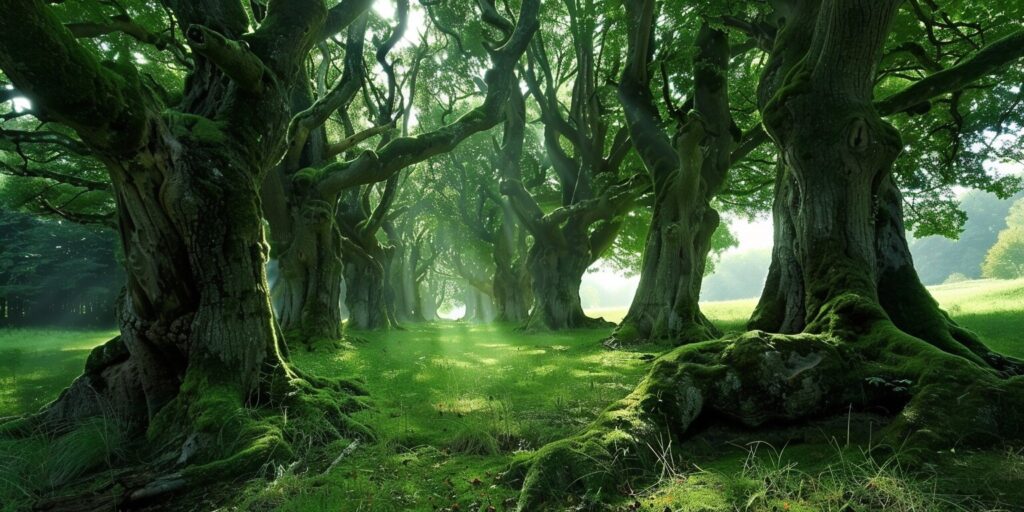Daily Life in the Viking Age, Norse Mythology, Tales of the Gods, Vikings
What Are Sacred Spaces in Norse Religion?
Welcome to our exploration of the fascinating world of Norse religion and mythology. In this article, we will dive deep into the concept of sacred spaces in Norse culture, uncovering their significance and role in the lives of the Vikings. Join us as we journey through the ancient tales and discover the hidden treasures of sacred places in Norse mythology.
Norse religion, practiced by the Vikings and other ancient Germanic tribes, embraced a rich tapestry of beliefs and mythological traditions. Sacred spaces held a special place in the hearts of the Norse people, serving as gateways to the divine realm and playing a pivotal role in their religious rituals and worship. Join us as we delve into the realm of sacred spaces in Norse religion and unlock the mysteries that lie within. Let us unravel the tapestry of mythology and spirituality that shaped the lives of the Vikings, uncovering the magic and allure of sacred places in Norse mythology.
The Importance of Sacred Spaces
In Norse religion, sacred spaces held great significance for both the Vikings and the followers of ancient Norse spirituality. These sacred places were believed to be the gateways to the divine realm, where the gods and spirits resided. They played a crucial role in religious rituals and worship, serving as focal points for spiritual connection and communion.
Sacred places for Vikings were not just physical locations but rather imbued with a sense of holiness and divine presence. They were regarded as channels for communication with the gods and ancestors, where prayers and offerings were made to seek blessings, protection, and guidance.
Ancient Norse spiritual locations spanned a wide range of landscapes, including mountains, forests, rivers, and other natural formations. These natural elements were revered and believed to be inhabited by spirits and divine beings. Such sacred spaces held immense spiritual power and were revered as places of immense importance.
Sacred Spaces and Religious Rituals
Various religious rituals and ceremonies took place in these sacred spaces. These rituals were central to Viking religious practice and aimed at establishing a deep connection with the gods and spirits. Food, drink, valuable items, and animal sacrifices were offered to honor and appease the deities.
Rites of passage, such as marriages and funerals, were also conducted in these sacred spaces to ensure the blessings and favor of the gods. These rituals were deeply rooted in Norse mythology and were seen as essential in maintaining spiritual balance and harmony.
The Spiritual Significance of Sacred Spaces
In addition to religious practices, Vikings’ sacred spaces held cultural and communal significance for the Norsemen. These places served as gathering points for religious festivals, where the community would come together to celebrate and partake in communal rituals.
The ancient Norse understood the importance of staying connected to nature, and these sacred spaces offered a tangible connection to the natural world and the divine. The beauty and serenity of these locations inspired awe, reverence, and a deep sense of spirituality.
Today, as we study the history and mythology of the Vikings, these sacred places in Norse religion offer valuable insights into their beliefs and way of life. They are reminders of the profound spirituality and connection to the natural world that characterized Norse society.
Types of Sacred Spaces
In the Norse religion, various types of sacred spaces held great significance and played essential roles in religious practices and beliefs. These sacred sites, both man-made and natural, formed a connection between mortals and the divine realm. Let’s explore some of the key sacred spaces in Norse mythology:
Sacred Sites
The Norse people constructed sacred sites to honor their gods and perform religious rituals. Temples were built as places of worship, where the community gathered to offer prayers and sacrifices to the deities. Burial mounds, often adorned with elaborate carvings and symbols, were revered as Vikings’ sacred places where the ancestors rested and communicated with the divine.
Natural Locations
In addition to man-made structures, natural locations held deep significance in Norse culture. Sacred groves and dense and tranquil forests were considered holy sanctuaries where gods and spirits resided. These serene groves provided a sacred space for rituals, communing with nature, and seeking divine guidance. Mountains were also revered as sacred sites, believed to be dwelling places of deities and serving as gateways between the earthly and divine realms. Bodies of water, such as lakes and springs, were regarded as sacred sources of life and were often associated with divine beings.
The Norse people found spiritual solace in these various sacred spaces, each offering a unique connection to the divine. Their reverence for these sites solidified the bond between humans, gods, and the natural world, shaping their religious beliefs and practices.
The Significance of Sacred Groves
In Norse culture, sacred groves held immense importance as spiritual and religious spaces. These enchanting forests, known as “viðr,” were believed to be inhabited by powerful spirits and served as gathering places for religious ceremonies and rituals. Deeply connected to nature, the Vikings considered these groves sacred sites within their religious landscapes.
Vikings would engage in various worship practices within these lush groves, paying homage to the deities of Norse mythology. These serene and secluded locations provided a tranquil setting for prayer, meditation, and communing with the natural and divine worlds.

The Spiritual Connection with Nature
Viking religious practices revolved around their reverence for nature, and sacred groves played a pivotal role in strengthening the spiritual connection with the natural environment. These groves were seen as sanctuaries where Norse individuals could seek solace, guidance, and divine wisdom.
Surrounded by towering trees and dappled sunlight, worshippers would come together to honor and appease the gods and goddesses of Norse mythology. The rituals performed in these groves ranged from offering sacrifices and reciting prayers to engaging in symbolic acts symbolizing their dedication to the divine.
Awe-inspiring Rituals and Ceremonies
The sacred groves were the backdrop for a myriad of rituals and ceremonies conducted by the Vikings. These gatherings represented significant moments in their religious calendar, marking important occasions such as harvest festivals, solstice celebrations, and rites of passage.
- Symbel: One such ceremony was the Symbel, a communal feast where participants shared mead in honor of the gods. These feasts were held within the sacred groves, fostering a sense of community and spiritual connection.
- Blót: Another essential ritual was the Blót, a sacrificial ceremony conducted to honor specific deities. Animals, such as goats or cattle, were ritually slaughtered, and their blood was offered to the gods as a sign of gratitude and worship.
These awe-inspiring ceremonies united the Norse community, strengthening their bonds and solidifying their connection with the divine.
The sacred groves embraced by the Vikings exemplify their deep-rooted appreciation for nature and its spiritual significance. Exploring these ancient sites allows us to glimpse into the rich religious practices and beliefs of the Norse people, immersing ourselves in their mystical and awe-inspiring world.
Mountains as Sacred Sites
Mountains held great significance in Norse religion, where they were revered as sacred sites and believed to be the dwelling places of gods and divine beings. These majestic natural formations were considered portals to the spiritual realm and played a central role in Norse mythology.
The Norse people believed that certain mountains served as sanctuaries for the gods, providing them with a space to observe and interact with the mortal world. These sacred mountains were seen as powerful and awe-inspiring, embodying the ethereal presence of the divine.
Among the sacred mountains in Norse beliefs, one notable example is Mount Hlíðarfjall, located in modern-day Iceland. According to Norse mythology, this mountain served as the dwelling place of the thunder god Thor, known for his strength and protective role in the pantheon.
Mountains like Mount Hlíðarfjall were often associated with specific gods or goddesses who were believed to reside there. These mountains became pilgrimage sites where worshippers would journey to pay their respects and seek divine favor through offerings and prayers.
The Spiritual Power of Sacred Mountains
For the Norse people, the mountains’ towering presence represented a connection between the earthly and spiritual realms. They believed that by venturing to these sacred sites, they could commune with the gods, seek guidance, and receive blessings.

The awe-inspiring nature of mountains, with their towering heights and often treacherous terrains, added to their mystique in Norse mythology. The challenges faced during the ascent to these sacred peaks were seen as symbolic tests of an individual’s determination and devotion to the gods.
- Sacred mountains were considered gateways to the divine realm.
- They were believed to be the dwelling places of Norse gods and goddesses.
- Certain mountains, such as Mount Hlíðarfjall, represented specific deities.
- Worshippers would journey to these sites to seek divine favor and offer prayers.
The sanctity of these mountains extended beyond religious rituals. They were also viewed as natural sources of power and wisdom, embodying the spirits and energies of the ancient land.
Today, the reverence for sacred mountains in the Norse religion continues. Many modern practitioners of Norse paganism and enthusiasts of Norse mythology still hold these mountains in high regard, visiting them as places of spiritual connection, meditation, and reflection.
Rituals and Worship in Sacred Spaces
Sacred spaces held a significant place in Norse religion, serving as the backdrop for various rituals and worship practices. Often found in Viking religious landscapes, these locations were considered Norse mythology worship sites where the divine and mortal realms intersected.
The worship conducted in these Viking religious landscapes was intricate and deeply rooted in Norse mythology. Central to the rituals were sacrifices, which included both animal offerings and, on occasion, even human sacrifices. These acts were seen as a means of expressing devotion and creating a connection between the worshippers and the gods.
Prayers played an essential role in worship practices within sacred spaces. They were uttered to seek blessings, guidance, and protection from the deities of Norse mythology. Worshippers offered prayers with utmost reverence and believed that their pleas would be heard by the gods residing in these hallowed sites.
Religious Ceremonies and Celebrations
Religious ceremonies in sacred spaces further strengthened the bond between the mortal and divine realms. These ceremonies encompassed various traditions, such as processions, chanting, and communal feasting. They were conducted to honor the gods, mark important events in life, or celebrate seasonal festivals.

One such festival that holds great significance in Norse religion is the Winter Solstice celebration, known as Yule. It was observed in sacred spaces, and worshippers gathered to pay homage to the gods and seek their blessings for the upcoming year.
The Power of Norse Mythology in Worship
Worshippers believed that by conducting these rituals and practicing their religion in sacred spaces, they could tap into the power of Norse mythology and establish a direct connection with the gods. The sacredness of these locations heightened the spiritual experience and reinforced their faith.
Legacy of Worship in Sacred Spaces
Although the Viking Age has long passed, the legacy of worship in sacred spaces continues to influence modern Norse spirituality. Many Viking religious landscapes are still considered sacred and serve as pilgrimage sites for followers of Norse paganism. These locations are revered for their historical and spiritual significance, offering a glimpse into the ancient rituals and practices of the Norse religion.
Preservation efforts are underway to protect and maintain these Norse mythology worship sites as cultural heritage sites. By respecting and honoring these sacred spaces, we can ensure the preservation of our shared history and the richness of Norse mythology for generations to come.
Sacred Spaces in Modern Times
In modern times, the ancient Norse spiritual locations continue to hold a special place of reverence for practitioners of Norse paganism. These sacred places in Norse mythology are not only reminders of a rich and vibrant past but also serve as important cultural heritage sites.
Many of these sacred places have been preserved and protected, allowing visitors and followers of the Norse religion to connect with their spiritual roots. The experience of visiting these ancient sites can be awe-inspiring, as they provide a glimpse into the ancient rituals and worship practices of the Vikings.
For those seeking a deeper understanding of the sacred places in Norse mythology, guided tours, and educational programs are available, providing insights into the history, symbolism, and significance of these spiritual locations. These immersive experiences allow individuals to connect with the spiritual and cultural legacy of the Norse religion.
The Importance of Preservation
Preserving sacred places for Vikings is vital for historical and cultural reasons and the spiritual nourishment and connection they offer modern practitioners. Protecting these ancient sites ensures that future generations can continue to experience the profound sense of connection that comes from visiting these hallowed grounds.
Local communities and governmental organizations are making efforts to safeguard these ancient sites. Through conservation initiatives and ongoing research, we gain a deeper understanding of the significance of these sacred spaces in Norse religion and their enduring impact on Viking culture.
Modern-Day Significance
Today, these sacred places in Norse mythology hold a unique allure for individuals interested in exploring their Nordic heritage or seeking a spiritual connection with ancient Norse spirituality. The stories and legends associated with these locations continue to captivate the imagination and intrigue seekers of knowledge.
Visiting these ancient sites allows individuals to immerse themselves in the rich tapestry of Norse mythology and gain a deeper understanding of the Vikings’ beliefs, rituals, and values. These sacred places serve as windows into a world that was once alive with spiritual energy and religious fervor.
Preserving the Past, Connecting with the Present
The preservation of sacred places in Norse mythology is a testament to the enduring significance of these ancient spiritual locations. By protecting and exploring these hallowed grounds, we can keep the flame of Norse religion and culture alive, honoring the wisdom and spirituality of our ancestors.
By embracing and celebrating these sacred spaces, we pay homage to our rich cultural heritage and foster a sense of connection and belonging both to our past and to the vibrant Norse community that exists in the present.
Final Thoughts
In conclusion, sacred spaces played a vital role in Norse religion and were deeply intertwined with the beliefs and practices of the Vikings. These sacred spaces, ranging from temples and burial mounds to natural landscapes like sacred groves and mountains, served as portals to the divine realm and focal points for religious rituals and worship. The Norse considered them sacred and revered them, believing that they were inhabited by gods and spirits.
The significance of these sacred spaces in Viking culture cannot be overstated. They were places of spiritual connection and religious observance and held cultural and social importance. Sacred groves, for example, were gathering places for ceremonies and served as centers of community life. Mountains were seen as sanctuaries for the gods and were often associated with powerful deities.
Even in modern times, these sacred spaces continue to hold relevance. They are treasured as cultural heritage sites and are still revered by modern practitioners of Norse paganism. Efforts are being made to protect and preserve these ancient landscapes, ensuring that their sacredness and historical significance are safeguarded for future generations.
In essence, the sacred spaces in Norse religion and the Viking religious landscapes were not just physical locations; they were the embodiment of a deep spiritual connection with the divine. They represented the intersection of the mortal and the divine realms, serving as places of worship, communal gathering, and cultural identity.

